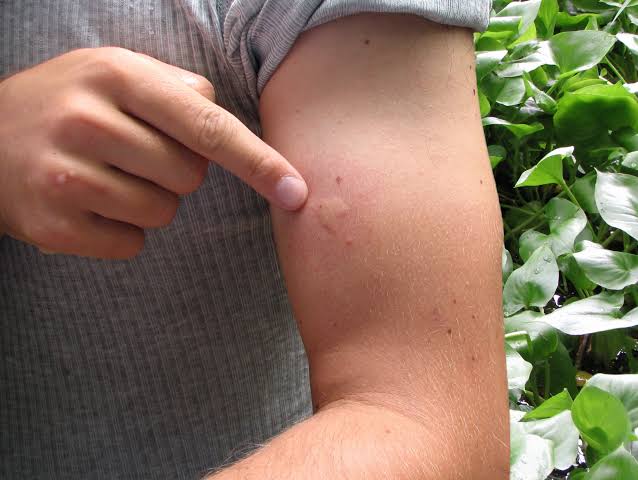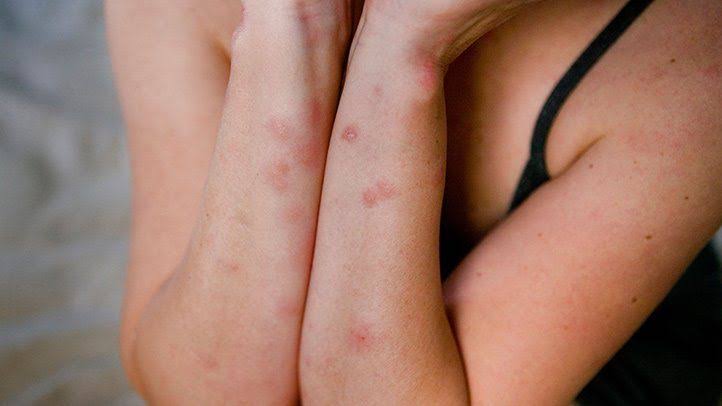When it comes to annoying insect bites, bed bugs and mosquitoes are often the culprits. Although the bites may appear similar, they originate from different creatures and have distinct characteristics. Understanding the differences between bed bug bites and mosquito bites is crucial in order to respond appropriately and take preventive measures. In this comprehensive guide, we will explore the distinctive features of each bite and discuss the treatments available.
Bed Bug Bites
Appearance

Bed bug bites typically occur in clusters and often follow a distinct pattern, such as a line or a zigzag. These bites are commonly found in areas that are exposed during sleep, such as the hands, arms, shoulders, neck, face, and legs. The bites are red and itchy, and they may have a blister on top.
Reaction Time
One of the key differences between bed bug bites and mosquito bites is the reaction time. People usually do not feel bed bug bites when they occur, and the symptoms may appear hours or even days later. Without further irritation, the symptoms typically resolve within a week.
Infestation and Behavior
Bed bugs primarily feed on blood and are most active at night. They must consume blood at least every 14 days in order to mate and reproduce. However, they can survive for several months to up to a year without feeding. Bed bugs tend to bite in areas where the skin is exposed during sleep.
Treatment
In most cases, bed bug bites do not require medical treatment unless an individual has an exceptional allergic reaction. To alleviate the itching and irritation, the affected area should be washed with soap and water. It is important to avoid scratching the bites, as it may cause secondary problems. Keeping the affected area clean and dry, as well as using antiseptic lotions and anti-itch creams, can help protect the skin and relieve itching. Over-the-counter antihistamines can be taken if needed.
Prevention
To prevent bed bug bites while traveling, it is advisable to thoroughly check beds for signs of bed bugs on mattresses and around the headboard. Suitcases should not be placed on the floor. At home, it is important to check items brought into the home, including clothes worn on trips and used furniture. Using bed bug-proof covers on mattresses and reducing clutter can also help prevent infestations. In the event of a bed bug infestation, it may be necessary to hire a professional pest remover who specializes in bed bugs.
Mosquito Bites
Appearance

Unlike bed bug bites, mosquito bites are generally isolated and appear randomly over parts of the body that are not covered by clothing. Mosquito bites resemble red bumps with a puncture wound in the center. In some cases, individuals who are very sensitive to mosquito bites may develop welts or larger raised areas.
Reaction Time
Mosquito bites are often instantly itchy and visible. The symptoms usually appear within a few hours or days after the bite. For most people, the itching and redness subside after 1 or 2 days.
Infestation and Behavior
Female mosquitoes are the only ones that bite, and the contact must last for at least 6 seconds for enough mosquito saliva to enter the bloodstream and cause a reaction. Mosquitoes are most likely to bite in the dark, between sunset and sunrise. They are attracted to carbon dioxide, human sweat, and warmth.
Treatment
Similar to bed bug bites, most mosquito bites do not require medical treatment. Washing the bites with soap and water is recommended. It is important to avoid scratching the bites to prevent further irritation. If needed, antiseptic lotions and anti-itch creams can be used to protect the skin and relieve itching. In some cases, over-the-counter antihistamines may be helpful.
Prevention
Preventing mosquito bites is essential to avoid the spread of serious diseases. Removing mosquito habitats by getting rid of standing water in pet dishes, buckets, and other containers is crucial. Bug screens for windows and doors should be checked for any holes. Wearing pants and long-sleeved shirts when venturing outside, especially in mosquito-prone areas, is advisable. Using insect repellent and installing yellow “bug” light bulbs can also help reduce the risk of mosquito bites.
Distinguishing Between Bed Bug Bites and Mosquito Bites
While bed bug bites and mosquito bites may initially appear similar, there are several characteristics that can help distinguish between the two.
Appearance on the Skin
Bed bug bites tend to occur in clusters and often follow a distinct pattern, such as a line or a zigzag. They are commonly found in areas that are exposed during sleep. Mosquito bites, on the other hand, are generally isolated and appear randomly over uncovered parts of the body.
Reaction Time
Bed bug bites often go unnoticed at the time of the bite and may take hours or even days for symptoms to appear. In contrast, mosquito bites are usually instantly itchy and visible.
Infection and Transmission of Diseases
Unlike mosquitoes, bed bugs are not known to transmit diseases. Mosquitoes, on the other hand, can spread serious diseases such as West Nile fever, dengue fever, Zika, and malaria. These diseases can have severe health implications and, in some cases, can be life-threatening.
Seeking Medical Attention
In most cases, neither bed bug bites nor mosquito bites require medical treatment unless an individual has an exceptional allergic reaction. However, there are certain circumstances in which medical attention should be sought.
Bed Bug Bites
Medical attention should be sought if an individual experiences a serious allergic reaction to bed bug bites, such as swelling of the throat or difficulty breathing. Additionally, if a large number of bites occur or if secondary infections develop, it is advisable to consult a healthcare professional.
Mosquito Bites
Similarly, if an individual experiences a severe allergic reaction to mosquito bites, such as hives, blisters, fever, or swollen joints, medical attention should be sought. Additionally, if no relief is obtained from over-the-counter anti-itch medications or if symptoms worsen, a healthcare professional should be consulted.
Other Potential Culprits
Itchy, red bumps on the skin may not always be caused by bed bugs or mosquitoes. Other insects can also be responsible for similar symptoms. Some potential culprits include fleas, flies, spiders, and mites.
Fleas
Fleabites can appear in clusters, similar to bed bug bites. They are usually found on the lower legs and feet.
Flies
Fly bites can cause itching and blistering on the skin. They are typically found on exposed areas of the body.
Spiders
Spider bites can result in redness and swelling. Some spider bites can be dangerous and may require medical attention.
Mites
Mites, such as scabies, can cause inflammation and itching. Scabies burrow into the skin, creating tunnels and causing discomfort.
Conclusion
Bed bug bites and mosquito bites may share some similarities in appearance, but they have distinct characteristics that set them apart. Understanding the differences between the two is essential for appropriate treatment and prevention. By recognizing the appearance, reaction time, behavior, and potential health risks associated with each type of bite, individuals can take the necessary steps to protect themselves from these annoying pests. Remember, if you have any concerns or experience severe reactions, it is always best to seek medical advice.






